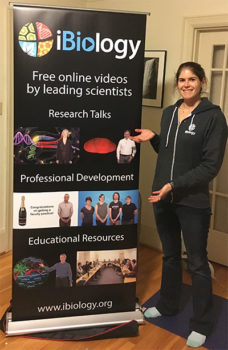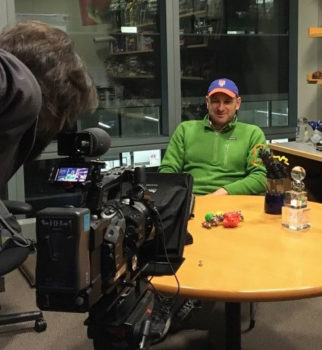Author: Lisa Munoz (Strategic consultant and science writer)

When I started working with the Science Communication Lab, they were in a period of great transformation — working to lay out the next phase of evolution for the organization. Coming out of a prolific phase of content generation through iBiology and then with the successes of the Wonder Collaborative’s full-length documentaries Human Nature and Picture a Scientist, the SCL was looking ahead to a new series of short films it was producing, as well as new ways to evaluate the films’ impact and to communicate that to our burgeoning community of educators and filmmakers.
In many ways, we have all had a front-row seat in the evolution of the SCL to the Lab it is now — seeing a new type of science film emerge, distinct from, yet complementary to, the previous generation of iBiology videos. While some of our viewers have embraced these changes, we recognize others miss the old iteration. So, we thought now would be a great time to delve deeper into why we made these changes. I sat down with the SCL’s Executive Director, Sarah Goodwin, and Executive Producer, Elliot Kirschner, to get their take and a tease of what’s to come.
Lisa: What prompted the shift in the type of films the SCL was producing?

Sarah: iBiology was founded in 2006 with the goal to get science knowledge out there for free to anyone with an internet connection. The way that we decided to approach this was through green-screen lectures, where scientists, often famous, would prepare special research talks for a scientific audience. We did that for a really long time, producing hundreds of videos, and people really loved the ability to dive deep into these science research stories. A range of people — graduate students, postdocs, scientists, the public — used them in a variety of settings.
Several years ago, we were talking to funders about new ways to have an impact. And they were asking us: What are you going to do that’s innovative or different? It really got us thinking about ways to experiment through this work — to tell stories differently and to potentially connect to new audiences.
Through our work on Human Nature, we learned that long interviews with scientists can yield so many amazing details about science and the process, while also putting the discoveries into a bigger context. We started using this interview-based approach for our online courses and then wondered if we could take that approach with these lectures.
This would have the added benefit of reducing the work burden on the scientists who had been spending so much time preparing their research talks. With interviews, we could craft the story, and the burden was on us the communicators to get the story out there. We also felt like we could get different things out of the interviews, still diving deep but also learning about the personality of the scientist, while bringing in other elements of production such as custom animations and music.
Lisa: How did it go with the first set of videos?
Sarah: We experimented with several videos before we applied for new funding. This included one with Dipti Nayak at UC Berkeley, who studies archaea, and another with Matt Meselson and Frank Stahl about their semi conservative DNA replication model. For these films, we were seeking to answer the question: Can we utilize interviews and fulfill some of the same goals we had with the previous research lectures? And we think they were ultimately a success; we were able to dive into the science story, while using animations and other techniques to really make the science clear. We’re still evaluating the specific outcomes from those films, but we really felt like there was something there.
Lisa: Are you able to do a head-to-head comparison of the previous model versus the new one?
Sarah: Yes, we can now compare the Meseleson and Stahl piece that we did that was interview-based with one where Matt Meselson gave a lecture about his discovery. We can evaluate what resonates with different audiences. Is one better for the public or better for education settings?
Lisa: When you decided to make a pivot, who were the stakeholders involved?

Elliot: We made the decision with feedback from the scientific community, including our Board of Directors. Our Board includes members of the National Academy, as well as people who teach science at the graduate and undergraduate level and are very committed to science communication. We also got a lot of encouraging feedback from our films Human Nature and Picture a Scientist. Both had a large number of screenings for scientific audiences. And we got positive feedback from everyone from senior PI’s, to graduate students and postdocs, as well as industry scientists, all around the world.
Lisa: What is the main area you are exploring with the films and the new approach, in terms of experimentation?
Elliot: We’re trying to figure out how we reach different audiences. And we have lots of questions like: Can we reach the professional science audience and science-curious audiences with one film? Or does it have to be more differentiated? Does a geologist approach a film about genetics differently than a non-scientist, educated member of the general public? We’re very interested in expanding our audience while keeping the scientific community as a key part of who we’re making films for.
We did notice that the green screens had limited appeal to a general audience. However, we don’t want to subscribe to a belief that our new approach to storytelling is not going to be of interest or useful to the scientific community.
Sarah: And I want to add that the one type of talk we decided to keep as lecture-based throughout this process is the Share Your Research talks. We’ve been doing this program for about six years, where the goal is to workshop a scientific talk by a grad student or postdoc for a general scientific audience. And it’s proven to be a great program, both for us and for the people who participated in it.
The end result is a 20 to 30 minute research talk. Pre-pandemic these were recorded in our green-screen studio, but over the last few years we’ve recorded them with remote recording kits. These talks by younger scientists really resonate with broad audiences. We still dive into a research story, but we work really hard to make a real story arc with the researchers.
Lisa: Is there anything else you would like to add?
Elliot: We see this as an evolution of our iBiology mission. The idea of how people approach or think about science, including scientists, is a rich area. It’s really important for the scientific community to engage with the stories of science and to think more broadly about science itself as a collection of different fields, with someone in one field learning more about another field. So we don’t see this shift as dumbing down science or an abandonment of the scientific community; quite the opposite. We want to experiment with how to best spur conversation within the scientific community.
I remember having a screening of Human Nature at UC Berkeley, where Jennifer Doudna who co-won the Nobel Prize for CRISPR does research. She couldn’t attend, but her department showed up in large numbers for it. And it was a very scientific discussion, with me and Sarah on the panel. But around the same time, we also had a screening for middle school students, and they had different questions.
We really do see film as a tool for different groups to use in different ways. This is version 1.0 of the experiment. As we work more in this space, we are excited to experiment more. We want people to watch our films and give feedback and learn from them. We see the audience as participants, not subjects of the experiment, but they’re also co-authors with us in terms of what we’re trying to find out about how to keep innovating around science films.




Leave a Reply